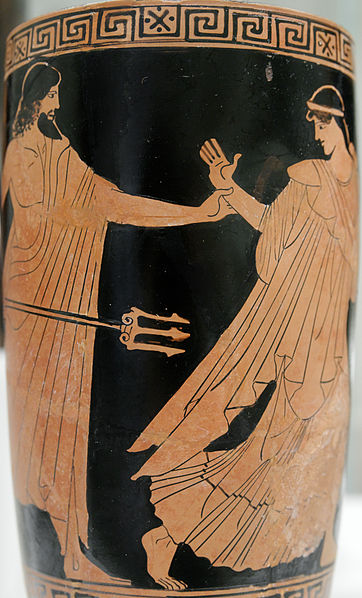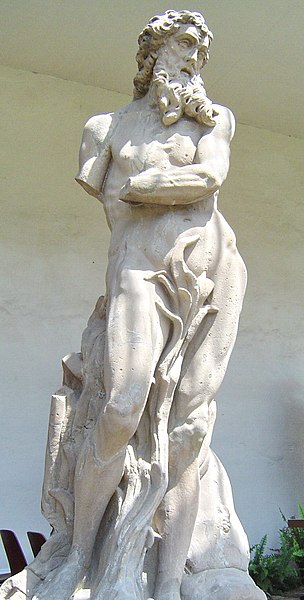Polyphemus is the one-eyed giant son of Poseidon and Thoosa in Greek mythology, one of the Cyclopes described in Homer's Odyssey. His name means "abounding in songs and legends", "many-voiced" or "very famous". Polyphemus first appeared as a savage man-eating giant in the ninth book of the Odyssey. The satyr play of Euripides is dependent on this episode apart from one detail; Polyphemus is made a pederast in the play. Later Classical writers presented him in their poems as heterosexual and linked his name with the nymph Galatea. Often he was portrayed as unsuccessful in these, and as unaware of his disproportionate size and musical failings. In the work of even later authors, however, he is presented as both a successful lover and skilled musician. From the Renaissance on, art and literature reflect all of these interpretations of the giant.
Polyphemus
Greek terracotta figurine, Polyphemos reclining and holding a drinking bowl. Late 5th to early 4th century BC, Boeotia. Museum of Fine Arts, Boston.
The blinding of Polyphemus, a reconstruction from the villa of Tiberius at Sperlonga, 1st century AD
Amphora painting of Odysseus and his men blinding Polyphemus (Eleusis museum)
Poseidon is one of the Twelve Olympians in ancient Greek religion and mythology, presiding over the sea, storms, earthquakes and horses. He was the protector of seafarers and the guardian of many Hellenic cities and colonies. In pre-Olympian Bronze Age Greece, Poseidon was venerated as a chief deity at Pylos and Thebes, with the cult title "earth shaker"; in the myths of isolated Arcadia, he is related to Demeter and Persephone and was venerated as a horse, and as a god of the waters. Poseidon maintained both associations among most Greeks: he was regarded as the tamer or father of horses, who, with a strike of his trident, created springs. His Roman equivalent is Neptune.
The Poseidon of Melos, a statue of Poseidon found in Milos in 1877
Poseidon greeting Theseus (on the right). Detail, Attic red-figured calyx-krater by Syriscos Painter, 450-500BC from Agrigento. BnF Museum (Cabinet des médailles), Paris
Poseidon pursuing a woman, probably by Achilleus painter, 480-450BC. Metropolitan Museum of Art, Manhattan NY
Statue of Poseidon in Germany by Johann David Räntz and Lorenz Wilhelm Räntz (1760).








